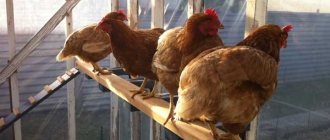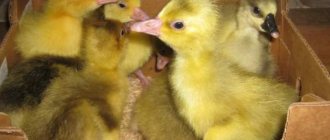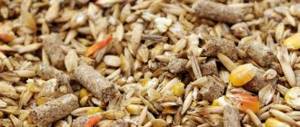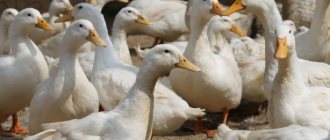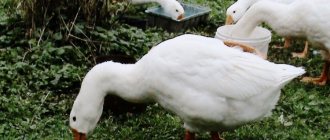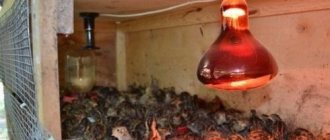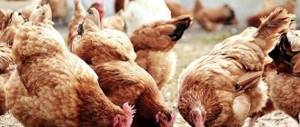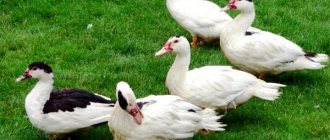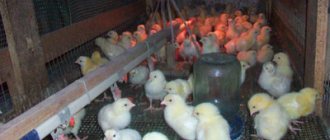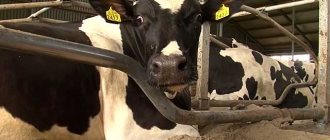Requirements for keeping geese in winter
Dense plumage and down really make the bird resistant to cold, even down to -40 °C. Naturally, this will require providing the correct content. Otherwise, due to constant dampness, the feather becomes dirty and loses density, and the bedding gets wet, causing the geese’s feet to freeze.
This can lead to disease and death of the bird population. Even a small shelter where the geese will spend the night or wait out bad weather will help. It can be built from anything, and large cracks can be sealed with straw or rags when it gets cold.
To prevent dampness from penetrating inside from the ground, it is better to make a plank floor and insulate it with bedding. Its height should be 50 cm, and for manufacturing it is suitable:
- hay;
- straw;
- sawdust;
- shavings;
- peat.
When the litter on top becomes dirty, you can replace it or simply add fresh material.
You can remove the smell of ammonia in a goose barn by sprinkling the bedding weekly with superphosphate. Consumption will be 400 g per 1 sq. m. If you use double superphosphate, you will need 2 times less of it. The product will not only get rid of the unpleasant odor, but will also dry the surface of the litter well.
It is not a good idea to keep geese indoors all the time. In mild weather, it is enough for them to spend the night in a shelter, and during the day it is better to walk outside. Even with a strong drop in temperature, geese are released for at least one hour.
Bird legs are not as frost resistant as the body. Therefore, it is recommended to regularly clear the snow in the walking area.
Where can you keep geese in the cold season?
Geese often keep warm by tucking their legs and beaks into their rich, downy plumage. This is what they do if they are cold. Therefore, these birds will definitely need shelter from rain, wind and snow. Dampness is especially dangerous for them, which means that the humidity in places where they are kept should not exceed 65%.
The following can be used as winter living space:
In the barn
Typically, a barn is a room for household purposes, adapted for storing equipment, keeping animals or storing feed. The barn can be brick, wood, or adobe. To make the birds comfortable, it is necessary to equip it with nests, feeders, drinking bowls and ensure good air exchange, absence of drafts and lighting.
Air exchange will be carried out using the supply and exhaust pipes. The cracks are caulked and the future poultry house is insulated. Natural lighting is provided by the window; in addition, electric light is also installed. Birds do not need additional heating, as they generate enough heat to avoid freezing in an insulated room.
- Advantages of barn maintenance:
- Geese have a separate home;
- if the barn is insulated, then the cost of preparing it for winter is minimal;
- if the barn will be used as a goose barn in the summer, then this would be a good choice of premises.
- The disadvantages of keeping a barn are:
- if equipment is stored in it, this is not very convenient for both the birds and the owners;
- during maintenance, the room will become contaminated with excrement - the equipment and the barn itself will have to be thoroughly washed;
- cleaning and disinfection will be difficult and illness may result.
Features of winter keeping geese
You can winterize birds in any empty commercial building. For example, a barn, chicken coop or greenhouse will do. The main thing is to properly equip the room to create the most comfortable conditions for the birds.
In the barn
Any wooden shed in which nothing is temporarily stored will become a reliable shelter. You can even quickly build it from old boards.
Preparing the shed:
- Check if there are cracks in the walls. Seal them thoroughly with fresh straw or dry rags. A sealant works well.
- If the gaps are very wide, place and nail a third one at the junction of two boards.
- When building a shed from scratch, be sure to make windows. This will allow sunlight to penetrate inside, which means you can turn off the electricity during the daytime.
Geese will overwinter well in a building made of stone or brick. But here, too, you definitely need to make a wooden floor and cover it with bedding material.
If the room under the poultry house is well insulated, there will be no need to heat it additionally: the geese will generate heat with their bodies sufficient to achieve a comfortable temperature.
In the chicken coop
A simple barn is often not sufficiently equipped for wintering, so that the bird quickly gains weight and lays eggs. It is better to build a chicken coop equipped with:
- drinking bowls;
- feeders;
- nests.
Wooden troughs or low buckets are used for drinking bowls. It is recommended to cover them with galvanized iron. It does not rust or rot like wood.
The feeder is constructed from two boards and several screws:
- Calculate the length of the boards, taking into account the number of birds. The more there are, the longer the feeding space is needed. Otherwise, part of the herd will remain hungry.
- The height of the feeder should be at the level of the goose's back. Fasten both boards to each other, maintaining an angle of 45-60 degrees. If the feeder is wider, the birds will simply rake up the food.
- Place 2-3 cross bars on top of the feeder. They will serve as handles for holding the feeder in your hands when carrying it, and thanks to them the geese will not scoop the food out.
In order for the geese to have a place to lay eggs, the poultry house needs to be equipped with nests. They are made in the form of open-top boxes made of plywood sheets or boards:
- Connect the boards so that you get a quadrangle 60 cm long, 50 cm wide and high. Treat the walls with lime mortar.
- Place nests along the walls. It is better to do this closer to mid-February so that the birds get used to the place where the eggs are hatched.
- On the front panel of each nest, make thresholds up to 10 cm high. Thanks to them, the litter will not spill out and the eggs will not roll out.
- Line the inside of each nest with straw or hay. The box needs to be filled almost to the top.
Calculate the number of nests according to the norm: for every 2-3 geese, 1 nest.
In the chicken coop you need to maintain an optimal temperature that is comfortable for the birds - not lower than +3 °C. As a rule, the chicken coop has everything you need, so nothing additional is required.
In the greenhouse
The best option, which does not require special expenses, is a greenhouse from which all plants have been removed by winter. The room is equipped, protected from wind and drafts, the glazed walls have good light transmission.
Greenhouse preparation:
- Strengthen the greenhouse by sealing cracks, if any.
- If winters are harsh, add heating to the greenhouse. This is especially true for film greenhouses, which will need additional heat during severe frosts.
- Carefully remove plant debris from the soil and level the surface.
- Place a bedding of straw.
This option for keeping poultry allows you to save on applying fertilizers next spring before planting vegetable crops in the greenhouse.
Is it possible to convert a greenhouse to keep geese?
With the onset of frost, there is no longer a strong need to operate greenhouse premises in the garden. These structures can be used for poultry. This approach to business can significantly reduce the cost of building a stationary goose barn. However, this method has its own characteristics, which it is recommended to familiarize yourself with in advance.
The poultry farmer should take into account that during the winter the birds in the greenhouse will excrete waste products. Litter can be used as a valuable fertilizer, but ammonia fumes can harm plants, and therefore it is important not to forget to ventilate the room well before planting various crops, and also take better care of installing a ventilation system.
The following conditions will be useful information for owners who decide to use a greenhouse for keeping domestic geese:
- it is necessary to install heating devices;
- the greenhouse needs to be well strengthened so that it is not damaged by precipitation and strong gusts of wind;
- lighting should also be carried out;
- It is best to house geese in a polycarbonate greenhouse.
Before transferring the bird to the winter room, mandatory cleaning is carried out inside: all dirt and accumulated dust are carefully removed. The ground is covered with bedding materials, here you can use the most convenient option:
- straw;
- wood shavings;
- peat.
Thanks to lighting fixtures, a heating system and ventilation, the required temperature and microclimate will be maintained inside the room.
Greenhouse for geese
After preparing the premises, the owner needs to think about the internal arrangement of the poultry house. There should be nests, containers for food and water - all this will allow the geese to feel as comfortable as possible in winter. It is worth talking about all these aspects in more detail.
Diet of geese in winter
Unlike in summer, in winter it is impossible to provide geese with ordinary grass and insects, which are an important component of a healthy diet. The winter diet is very different; it must be prepared according to certain rules.
Nutrition
In November and throughout December, meals should be two meals a day. The morning feeding is a mash, and the evening feeding consists only of whole grains. January should be spent on three meals a day, then until March inclusive (this is the time of laying eggs) on four meals a day according to the following scheme:
- day - wet mash;
- morning and evening - whole grain.
For food in winter, forage grasses are required. They are given 0.3 kg per individual daily. Nettle and alfalfa are recommended; meadow herbs in the form of hay are also suitable. Such roughage can be added dry, but in steamed form it is better absorbed:
- Chop coarse hay and pour boiling water over it.
- After 5-10 minutes, mix with chopped vegetables - beets, carrots, rutabaga or potatoes.
- Oat chaff is good to use instead of hay.
Geese love oats very much; they are added whole to their food. But wheat and barley cause obesity in birds kept at home, which significantly reduces egg production. An important part of the diet in the winter months are dried herbs and leaves, acorns, and vegetables.
Rules for feeding geese in winter:
- Hay is prepared for geese in quantities of 15 kg per bird. These can be dried or ensiled meadow grasses.
- A useful addition would be brooms made from dry branches of linden, birch, willow, and oak. Dry preparations need to be steamed and hung along the walls of the poultry house.
- Oak acorns are a must. The norm is 6 kg per individual. Dried acorns are peeled from the shell before adding to the mash, and boiled for 1 hour.
- The lack of grain is replenished with raw and boiled potatoes. In order for the goose to get used to such food, grated potatoes are introduced into the chicks’ diet from childhood.
- The mash with the addition of potatoes and other vegetables is prepared at one time, otherwise it may turn sour after a few hours. This will lead to gastrointestinal upset in birds.
- When replacing grain with potatoes, the proportion is 3:1. For example, 3 kg of potato mash with herbs fully replaces 1 kg of whole grains.
When geese begin the mating period, it is recommended to leave oats in the feeder overnight. This is especially important for males: due to frequent sexual intercourse, they lose weight, and this affects the quality of fertilization.
It is better to feed the geese indoors while the geese are walking outside. The following products are used for feeding:
- whole wheat, barley, oats – 80 g;
- grated carrots – 20 g;
- baker's yeast – 4 g.
The quantity is given per individual.
Vitamin supplements
Even good food in the required quantities will not provide domestic geese with the necessary microelements. The reason for this is the lack of sunlight, cold, lack of fresh grass and insects, and low mobility. Therefore, it is necessary to introduce vitamin supplements into the diet.
Nutritional supplements are easy to make yourself. For example, to provide the body with vitamins A and D, fish oil and wheat germ are added to the feed. Sprouted wheat is prepared as follows:
- Fill the barley with water at room temperature and leave it indoors for 2 days.
- Scatter the swollen grains on a flat surface so that they almost do not touch and the layer is uniform.
- On the 3rd day, sprouts will appear. In a couple more days they will get stronger, each grain will “hatch”, and you can add the resulting product to the wet mash.
In winter, birds will also need calcium and mineral supplements. Suitable for this:
- shell rock;
- shells of nuts, eggs;
- chalk.
These substances can be given together or separately. The main thing is to grind them well to make it easier for the geese to eat. It is recommended to add fine gravel: it helps the birds' stomachs digest food.
Drink
It is a mistake to assume that snow will replace water for poultry in winter. In fact, the drinking regime for geese in the cold season is more important and more difficult than in the summer.
A lack of fresh water will cause circulatory problems in birds, which will lead to a breakdown of the nervous system. This state will turn into constant aggressiveness or, conversely, lethargy. In any case, the geese's egg production will decrease.
The amount of water required is 2 liters per day for each bird. The drinking bowl container must be uncontaminated, so liquid stagnation should not be allowed. The water must be changed every day.
Try to make a drinking bowl with running water. But if this is not possible, use wide, low buckets, wooden or galvanized troughs that can be easily emptied and rinsed.
What to feed geese in winter at home
In winter, birds do not have the opportunity to independently obtain food in pastures and reservoirs in order to diversify their diet. This makes some adjustments to winter nutrition. In the cold season, there are three meals a day: morning, lunch and evening. The time must be clearly defined in order to develop a feeding reflex in the bird.
Hay
They have been making hay since the summer: each forage crop is mowed at the appropriate time, dried in the sun and then dried in a shaded, well-ventilated place. The hay is then stacked in stacks or stacks on special platforms.
Hay baling is considered a more advanced technology, but this method is not possible in small households, as it requires special equipment.
Geese are given dry or steamed hay; the main condition is to chop it thoroughly. For this product to be especially useful, it must be composed of different grains. Dry nettle does not lose its beneficial qualities when dried, so it can be prepared and given to birds in winter.
Green flour
Grass meal is prepared by artificially removing moisture from perennial and meadow grasses. The raw materials are pre-dried in the sun, leaving them on the field after mowing. Then they are collected and crushed as thoroughly as possible using special mills and dried in dryers. The humidity of the finished product should not exceed 12%.
Did you know? In the American cotton fields, there is a practice of calling geese to weed the beds. Geese do not eat cotton, but they effectively fight weeds.
Before sending the finished flour for storage in bags, it is kept in a container for a day. Flour is stored in a dark room where there is no access to moisture. This product is rich in carotene, protein, vitamins and minerals.
Silage
An extremely valuable winter product because it retains its beneficial nutritional qualities during long-term storage. Geese receive vitamins, amino acids, beta-carotene and successfully gain weight. The most optimal for ensiling are green corn, beets, cabbage, carrot tops, and legume-cereal mixtures.
Silage is forage crops harvested without access to air, fermented in their own juice. If there are a lot of sugar-containing crops in the silage, fermentation may occur. Silage is prepared at the rate of 35 kg per adult goose.
It is considered high quality if it has a light brown color and a slightly sour smell.
Basic rules for procurement:
- compliance with the optimal mowing phase for each type of plant;
- pre-drying (increases sugar concentration);
- thorough grinding (lactic acid bacteria multiply well in the released plant juice);
- the moisture content of the mass is no more than 70% (moisture can be removed using straw, and added by introducing pumpkin or water);
- good sealing (to displace air as much as possible);
- storage in sealed trenches or pits (without access to oxygen and water).
To store silage, you can make a hole: dig the ground to a depth of two meters with an expansion upward, coat the walls with clay. The width and length of the pit is at the discretion of the owner. The bottom is covered with straw or dry leaves. Then the ground greens are placed there in layers of 25 cm, compacting.
Then the tightly packed pit is covered with film and pressed down with bales of straw (can be sprinkled with earth). To protect from the wind, a canopy is installed over the pit, and grooves are dug to limit the access of moisture. Feed is taken from the silo at one time - in the open air it quickly loses its beneficial properties.
Seeds
Weed seeds, as well as seeds and fruits of some trees (horse chestnut, acorn) can be easily stored for the winter, providing your goose flock with additional food. Quinoa, nettle, burdock, manna, chicken millet, horse sorrel, beech, linden, ash, oak, acacia, and birch catkins are used.
The seeds are dried and the fruits are soaked in water for several days to remove the bitter taste.
Brooms from deciduous trees
The leaves contain beneficial carotene, so they also need to be stored for future use. In temperate climates, it is best to collect them in June, since the concentration of vitamin A is maximum during this period. Leaves useful for birds include maple, aspen, birch, poplar, willow, acacia and elderberry leaves.
For ease of preparation and storage, the collected material is tied with small brooms and dried in the open air, but in the shade. In winter, these brooms can be ground into flour and added to mash, or you can simply hang them in the poultry house and let the birds peck this vitamin “supplement” themselves.
aquatic plants
Duckweed, elodea, and salvinia contain many useful minerals, vitamins and microelements, including iodine, magnesium, cobalt and copper. This product can be mixed into wet food or given as a separate food.
Did you know? If a goose is not given water for two days, its egg production completely disappears. Recovery can be very difficult and take a long time.
The preparation of aquatic plants occurs in the same way as the feed already mentioned above: some are ensiled, hay is prepared from sedge and reed, and cattail and manna, for example, are used for grass meal.
Vitamin complexes
Coniferous trees (spruce, pine) will help compensate for the lack of vitamin C. Also, consuming pine needles has a positive effect on the gastrointestinal tract, increases egg production and the nutritional value of eggs. Goslings develop more actively and acquire good immunity.
To prepare such a useful supplement, it is enough to dry the pine branches and grind them together with the needles using a meat grinder.
Amino acids are very important for geese, so in winter it is useful to give them meal and cake. Make sure that the cake is fresh, not musty and does not have a bitter aftertaste. Geese love meal (oil production waste) more.
Grain is the main source of nutrients during the cold season. Oats are rich in fiber, sprouted barley compensates for the lack of vitamin B.
Carrots, dried and salted, are a source of useful vitamins; birds must include them in their diet. Cabbage can also be pickled for winter. It is rich in amino acids, and one goose can eat up to 200 g per day.
At the beginning of autumn, rowan and hawthorn are harvested, which will also compensate for the lack of vitamins in the bird’s body in winter. It is best to store the collected bunches in a barn or attic, you just need to make sure that it is dry.
Need for a walk
In the cold season, even in frosts, you need to let the geese out for walks. They must last at least an hour. This way the birds develop their paws and make it possible to digest the food well.
If geese lead a sedentary lifestyle, then all their reserves are stored in fat, and not in muscles. Also, fat birds stop laying eggs, and then it is almost impossible to establish this process.
In winter, geese can be allowed to swim in shallow ponds. This way they will develop their muscles, and the meat will become very tasty. At this time, the owner can calmly clean the room and ventilate it.
Organization of walking
Geese need a daily walk lasting at least 1 hour. This helps them warm their paws and digest food better. Sedentary birds accumulate fat well, but do not form muscle tissue well. This is bad for the geese - they have problems laying eggs due to obesity. And it’s also bad if geese are raised for meat, since very fatty carcasses are not very readily bought.
Walking can be organized in the garden plot next to the poultry house. The standard area is 10 sq. m per individual. But geese can walk just fine in a smaller space. To prevent paws from freezing, snow and ice are removed from the walking area. In this case, what is important is not what temperature the geese can withstand, but the fact that their paws do not feel the cold and the birds can freeze them during such a walk. The walking area is fenced with a net. The site is cleared of snow and covered with bedding - straw or other material.
Feeders and drinking bowls are also installed here. If the paddock is not equipped with a centralized watering system, then you can install a container with water. To prevent the water from freezing, you can lower a heated stone into it. It will maintain normal water temperature.
A walk at an air temperature below –15 °C should last no more than 1 hour. But at temperatures just below 0 °C in sunny weather, birds can spend almost the entire daylight hours walking.
How to water geese in winter
Contrary to popular belief, geese need sufficient drinking water not only in summer, but also in winter. In just one day, one adult can drink up to 2 liters of water, so it is necessary to carefully ensure that the drinking bowls are constantly filled (Figure 4).
When keeping a large livestock, it makes sense to install in the goose barn not ordinary drinkers that are filled manually, but automatic structures with flowing liquid. This will ensure that all birds are getting enough water. Melt water obtained from snow is considered extremely beneficial for geese. However, you need to ensure that the snow to obtain it is clean and free of harmful impurities.
Figure 4. Options for drinking bowls made from scrap materials
If the geese's watering regime is disrupted, the females' egg-laying regime will be disrupted. If there is no drinking water for more than two days, females will simply stop laying eggs, and males will have reduced sexual activity.
How can you replace greens?
Keeping geese in winter frightens novice poultry farmers because they do not know what can replace the green, juicy grass that geese love so much. You can dry nettles in the summer. When dried, its beneficial properties remain the same as when fresh. Vegetables should be the main food in the autumn.
It is important to remember that you should never give sprouted potatoes to birds, because they contain a toxic substance. Also, you should not give water in which potatoes were boiled: this can cause a number of serious gastrointestinal disorders and lead to death. With the arrival of autumn, so that wintering does not affect the health of the geese, it is necessary to switch them to high-carbohydrate food. You can enter hay into the menu. Moreover, it is desirable that it be dried not in the sun, but in a well-ventilated, shaded place.
Hay should be given dry or steamed. The most useful is considered to be hay dried from various cereal crops. In winter it is necessary to increase the number of feedings. The most important thing is that the food is as balanced as possible and rich in vitamins and minerals.
Caring for geese in winter
Due to worsening weather conditions, winter care is more thorough than summer care. Its rules are simple, but compliance is mandatory:
- Keep the plumage clean. Dry and clean feathers will protect birds from hypothermia and illness. Therefore, regularly change the bedding to dry material.
- The minimum suitable temperature in the poultry house in winter is +3…+5 °C. Below this level, geese will have to eat more and stop laying eggs to maintain energy.
- The bird needs long daylight hours, about 14 hours, for the entire breeding period. And if in summer this is the natural duration, then in winter equip the coop with lighting devices at the rate of 5 W per 1 sq. m. Turn on the light at about 5 am, turn off after sunrise. Evening shutdown – from the beginning of sunset until 19:00.
- Provide the males with food. They take care of the geese and often go hungry because they wait for the females to eat. Ganders need to increase their feeding rate by 20%.
Please note that each gander in good condition, strong, healthy and well-fed, will efficiently fertilize 3-4 geese, ensuring their high egg production.
Features of keeping in winter
Despite good egg production, it is considered low compared to other varieties of poultry. For this reason, geese are usually bred for breeding. The presence of optimal conditions is mandatory for their successful cultivation. The cold season has its own nuances:
- the presence of an insulated poultry house, where there is at least 1 square meter for each adult. m.;
- clean environment;
- diet, selected according to the characteristics of the winter period;
- dry litter;
- properly equipped nests.
It is important to properly insulate the room where the bird will spend the winter. A special gooseneck is suitable for this, but if it is not available, you can use a barn for these purposes.
Birds tolerate frost well, but do not like drafts. That is why any cracks must be caulked with hay. It is also recommended to apply slaked lime to the walls.
Dry plumage protects well from hypothermia. If wet bedding is used, the feathers become dirty and their protective properties are reduced. Birds look disheveled and unattractive. To make bedding, you can use:
- straw;
- sawdust;
- peat;
- shavings.
Its layer should be 50 cm. It is better to sprinkle with superphosphate to ensure dryness. This must be done every day. This is a substance that enriches the litter with mineral components, removes excess ammonia and dries the structure of the material. Approximately 400 g of superphosphate is required for each square meter of poultry house
It is also important to promptly update the litter if it becomes dirty. Humidity should not be excessive, otherwise it will negatively affect the offspring
Using a barn and greenhouse
You can allocate a barn for wintering. Some homeowners even make their own poultry house from old boards. The main thing is that the structure is strong and has no cracks. Where 2 boards join, you can use a third nailed on top to cover it. It is good to arrange windows to let in sunlight. The procedure also allows you to save certain amounts on lighting.
A brick barn is also suitable for waiting out the winter. The floor in such a room can be wooden or adobe. A well-equipped poultry house does not require additional insulation. This is explained by the fact that geese themselves produce a sufficient amount of heat.
Even a greenhouse can become an excellent goose breeder. The room is completely closed from drafts and allows light to pass through. But it is advisable to install heating in the greenhouse so that it can be turned on in case of severe frosts. Before housing the bird, the greenhouse must be removed.
Both film and polycarbonate models are suitable for housing domestic animals. The second option is more preferable, since such material warms up well under the influence of the sun's rays. Poultry farmers recommend resorting to this option in winter in order to save on fertilizer in the future.
Arrangement of a gooseneck
And yet, despite the advantages of various premises, the best option for poultry is a goose coop. Such a room guarantees excellent rates of egg laying and weight gain. Here you can provide good care for the bird. What should be in such a structure:
- feeders;
- drinking bowls;
- nests
Dishes for drinking water should be made of galvanized iron. But in the absence of this material, miniature buckets and a wooden trough will do. The feeder is made using 2 boards nailed to each other at an angle with screws. The resulting length must be enough to feed the poultry, otherwise you will have to face a lack of nutrition, and someone will certainly go hungry. This, in turn, will cause a decrease in productivity.
The feeder should have a height so that its upper area reaches the backs of the geese. Too wide options are undesirable, as individuals will rake up the food. To prevent this, breeders advise strengthening transverse strips on the surface of the feeder. They can serve as carrying handles in the future.
Geese start laying eggs after wintering in February. At that time, in the room where the poultry lives, there should be nests made of plywood and boards. These objects are a box that is open on a separate side and treated with lime solution. Its width and height should be 50 cm, and its length - 60 cm. They should be installed along the entire perimeter of the side walls no later than January 15. They should have a threshold in front that will prevent eggs from falling out and litter from scattering. You should adhere to the norm: 1 nest for 3 geese when calculating the optimal number of nesting sites.
Requirements for keeping geese
If it’s still cold outside and there’s no suitable shed, you can use them as a summer kitchen. Goslings 1-5 days old need a temperature of 27-28 degrees, for chicks 6-15 days old - 24-26, individuals up to 20 days can already withstand temperatures up to 18 degrees.
If the regime is violated, losses in the livestock are possible. What is dangerous here is overheating, from which the bird dies, and cold - then the goslings will stick together and can crush each other.
As for the area, up to three weeks per 1 sq. m can get along with up to ten individuals, in extreme heat - 6-7 pieces. If the livestock is large, then it is necessary to divide the territory with partitions. Water and food should always be freely available.
Summer keeping of geese
When trying your hand at poultry farming, start by raising geese for slaughter. Usually, young animals are kept for 2-2.5 months, and solid buildings are not needed, especially since the bird is outside all day, coming indoors only at night. An ordinary barn or even a shed will be suitable for maintenance; you can also build a mobile gooseneck. The latter is made from wooden slats, which are covered with mesh, and the top is covered with roofing felt.
When small goslings are moved into the barn, the room is thoroughly cleaned and disinfected, and it is highly advisable to whitewash the walls and ceiling. A 10-15 cm layer of straw is poured onto the floor.
Geese make maximum use of pasture, so the main problem with nutrition is solved on pastures.
Goslings are accustomed to walking from the age of one week, and the bird can graze where other animals will not go: wetlands, ravines, etc.
If you are limited to a closed area, then you need to organize areas for walking with forbs. Pasture size is calculated based on age:
- for young animals up to two months, 1 square meter is enough. m/individual;
- birds from two months already require 5 km. m/individual;
- adult geese – 15 sq. m.
In the evening, the livestock should be fed with grain, and if the walking areas are already well eaten, then in the morning.
Keeping geese at the dacha can be in an aviary. Usually such areas are small, pastures are not readily available, so it is enough to build an enclosure and provide a ready-made diet: mown grass, feed, food waste, aquatic plants, root vegetables. Vitamin and mineral supplements, as well as gravel (1% of the weight of the feed) should be mixed into the feed. The bird has no teeth, and food is ground in the stomach using small stones - up to 6 mm.
Geese are waterfowl, and it is optimal for the flock to have access to water. But if there is no pond, lake or river nearby, then place a large trough for swimming, not forgetting to change and add water.
Differences in summer and winter food
Keeping geese at home in winter will be more difficult in terms of feeding. In the summer, it is enough to feed the bird twice a day with grains; the rest of the food it gets itself while walking
In order to properly create a nutritious winter menu for geese, it is important to study the features and value of each grain product
- Barley contains vitamin B, so its use is indicated not only for sexually mature individuals, but also for slightly stronger young animals.
- Oats contain a lot of fiber, although in terms of energy value they are inferior to barley. It is recommended to introduce it into the diet of geese from the beginning of egg laying.
- The best option is to add crushed corn, which is included in all kinds of mash.
- An extremely useful product for geese is wheat seeding.
- It is not recommended to feed rye: it can provoke the appearance of various serious illnesses.
- Grain must be given in sprouted form.
Bone meal and hay dust are extremely rich in proteins and multivitamins. Also, winter feeding should include vegetable protein: legumes, soybeans, meal. Legumes should be boiled before feeding, because it is after cooking that their beneficial qualities increase. Another important point is the introduction of mineral supplements. Today on the Internet you can find a video that describes in detail all the herbs that can be prepared for poultry for the winter, and also shows how best to dry them.
Geese. Conditions for keeping geese in winter at home in a greenhouse. Geese, profitable or not.
Keeping geese in winter
Keeping and feeding geese. Poultry farming // Alekseev Farms
Peculiarities of breeding geese in winter. How geese tolerate the cold.
Keeping geese in winter/ Conditions for breeding geese/ Domestic geese
Formation of feeders
Keeping geese at home (photos of wintering options in the article) is accompanied by the arrangement of good feeders. The best option is two boards, knocked down at an angle. At the top of the sides you need to make additional strips that will not allow the bird to climb inside.
Shields should be nailed lengthwise to prevent the geese from scattering food. The feeder should be large, or several of them should be made so that the birds feed at the same time and do not require supplements, otherwise it will be difficult to monitor the correct diet. This threatens excessive fat gain.
The upper limit of the feeder should not be lower than the bird's back. Periodically, the feeders are washed and dried to avoid rotting. Separate small troughs can be built for hens.
Keeping birds in winter in Siberia
Some owners experiment and keep the bird outside in cold weather. Scientists have proven that geese can withstand temperatures below -60 °C. To successfully winter in the open air, you need to make a very high flooring of straw on the site so that the geese can burrow into it.
Keeping geese outside in winter requires an increased diet in both quantity and calorie content. This way the geese will gain fat mass and be able to safely endure severe frosts. It is also necessary to arrange nests and feeding areas outside.
Some owners on the street simply put up three partitions without a roof so that the bird can hide from the wind. To prevent the paws from freezing, they can be lubricated with fat. It has been proven that large breed geese tolerate severe frosts better.
Keeping geese in winter in Siberia requires additional costs for food and care. So it is more advisable to put together at least a small shed from boards without additional heating.
Disease Prevention
The main problems that can cause illness in birds during the cold period are the following:
- a sharp change in diet, as a result - a decrease in immunity;
- lack of physical activity as a cause of metabolic disorders and obesity;
- dampness and drafts, causing hypothermia and colds.
Most often, organizing proper nutrition and walking helps to avoid these problems. It is important to keep the entire area where the herd lives clean. But it will not be superfluous to comply with medical safety measures, namely:
- Before moving the birds in, completely clean the goose house, disinfect the surface and equipment using caustic soda (2% solution).
- Replace the bedding at the latest when it is a quarter dirty.
- Adhere to the bird vaccination schedule established by veterinarians.
- Make sure that there is no infection with helminths and other parasites, take action if a problem is detected.
- When new birds appear in the flock, quarantine them.
- Completely eliminate contact between domestic geese and wild birds.
- If you notice a sick goose, immediately isolate it from the rest of the flock and contact a veterinarian.
Tricks for keeping geese in winter
Only healthy and strong individuals without visible pathologies are left for the winter. Feeders and drinkers should be cleaned daily to prevent frozen food from remaining at the bottom.
There should always be food hanging on the walls to boost the bird’s immunity:
- chalk;
- shell rock;
- egg shell
It is necessary to organize access to sunlight in the barn. Then the bird will survive the winter more easily with the help of good immune function. Feeding geese can be done outside in winter.
Eggs must be collected very early and monitored when the geese lay them. This is especially important when geese are kept in the open air in winter in Siberia. Because eggs collected at the wrong time in the cold crack very quickly.
The water in the drinking bowls is changed at least 3 times a day. It is impossible to feed geese with snow alone, otherwise they will not get drunk, and this threatens to disrupt the blood circulation process. Then the geese become too noisy or, conversely, weak and sleepy.
Geese outdoors in winter
It should be immediately clarified that keeping geese outside around the clock during the winter is impossible. The fact is that these birds are very sensitive to dampness, precipitation and piercing wind, so they should be provided with shelter from adverse weather conditions.
Figure 5. 24-hour street maintenance in winter is only suitable for the southern regions
Fortunately, birds are not too sensitive to cold, so building a barn for them will not cost much. It is enough to erect a wooden building with a roof, install drinking bowls, feeders and nests inside, as well as fence and clear the walking area next to the poultry house from snow. In such conditions, the geese will spend their free time walking, and during bad weather they will hide in the barn (Figure 5). In addition, you will be sure that a sharp night snowfall will not destroy your livestock.
When arranging a barn, it should be taken into account that it is better to make the floors wooden and cover them with a half-meter layer of dry litter (you can use sawdust, straw or peat). As it gets dirty, the top layer of bedding is changed so that the geese do not suffer from high humidity.
The importance of walking space
Even with the onset of a cold period, the bird is allowed to walk outside. This type of exercise will allow the geese to stay in shape and not gain excess weight. If the yard is covered with snow before a walk, it is recommended to clean it or throw thick layers of straw in several places. This technique allows you to prevent frostbite of the extremities.
Winter walking of geese
If you have a shallow reservoir, you should not deny birds the opportunity to swim. The natural structural features of the feather cover allow geese to remain warm even in cold water. Of course, it’s not worth taking your herd to a distant pond for a swim.
